SINGAPORE: Abu Dhabi Petroleum Ports Authority will deny entry to any ships carrying cargoes going to or from Qatar, two shipping circulars seen by Reuters on Thursday showed.
The new circulars, which were issued late on Wednesday, re-introduced the ban on ships travelling from or destined to arrive in Qatar, after the authorities had eased restrictions just a day earlier.
The ban on all vessels carrying the Qatari flag and vessels owned or operated by Qatar remains in place and those ships will not be allowed into its petroleum ports, the circulars said.
Abu Dhabi Petroleum Ports Authority tightens Qatari shipping restrictions
Abu Dhabi Petroleum Ports Authority tightens Qatari shipping restrictions

Dubai DXB airport sees record 2024 traffic after 8.4 percent rise in Q1

- Dubai airport welcomed around 23 million passengers in January-March period, operator says
- India, Saudi Arabia and Britain were top three countries by passenger volumes in first quarter
DUBAI: Dubai’s main airport expects to handle a record passenger traffic this year after an 8.4 percent rise in the first quarter compared with a year earlier, operator Dubai Airports said on Tuesday.
Dubai International Airport (DXB), a major global travel hub, welcomed around 23 million passengers in the January-March period, the operator said in a statement, noting that the uptick was partly driven by increased destination offers by flagship carrier Emirates and its sister low-cost airline Flydubai.
“With a strong start to Q2 and an optimistic outlook for the rest of the year, we have revised our forecast for the year to 91 million guests, surpassing our previous annual traffic record of 89.1 million in 2018,” CEO Paul Griffiths said in the statement.
Dubai is the biggest tourism and trade hub in the Middle East, attracting a record 17.15 million international overnight visitors last year.
Its ruler Sheikh Mohammed bin Rashid Al-Maktoum last month approved a new passenger terminal in Al Maktoum International airport worth 128 billion dirhams ($34.85 billion).
The Al Maktoum International Airport will be the largest in the world with a capacity of up to 260 million passengers, and five times the size of DXB, he said, adding all operations at Dubai airport would be transferred to Al Maktoum in the coming years.
DXB is connected to 256 destinations across 102 countries. In the first quarter, India, Saudi Arabia and Britain were the top three countries by passenger numbers, Dubai Airports added. ($1 = 3.6729 UAE dirham)
Israel, Hamas reject bid before ICC to arrest leaders for war crimes

- Israel slams as a ‘historical disgrace’ the demand to arrest their leaders for war crimes
- US President Joe Biden denounces the ICC bid as ‘outrageous’
RAFAH, Palestinian Territories: Israel and Hamas, engaged in heavy fighting in the Gaza Strip, both angrily rejected on Monday moves to arrest their leaders for war crimes made before an international court.
The International Criminal Court’s prosecutor Karim Khan said he had applied for arrest warrants for top Israeli and Hamas leaders over the conflict.
Israel slammed as a “historical disgrace” the demand targeting Prime Minister Benjamin Netanyahu and Defense Minister Yoav Gallant, while the Palestinian militant group Hamas said it “strongly condemns” the move.
Israel’s top ally the United States joined the condemnation, while France said it supported the court’s independence and its “fight against impunity.”
Netanyahu said he rejected “with disgust The Hague prosecutor’s comparison between democratic Israel and the mass murderers of Hamas.”
Khan said in a statement that he was seeking warrants against the Israeli leaders for crimes including “wilful killing,” “extermination and/or murder,” and “starvation.”
He said Israel had committed “crimes against humanity” during the war, started by Hamas’s unprecedented October 7 attack, as part “of a widespread and systematic attack against the Palestinian civilian population.”
Khan also said the leaders of Hamas, including Qatar-based Ismail Haniyeh and Gaza chief Yahya Sinwar, “bear criminal responsibility” for actions committed during the October 7 attack.
These included “taking hostages,” “rape and other acts of sexual violence,” and “torture,” he said.
“International law and the laws of armed conflict apply to all,” Khan said. “No foot soldier, no commander, no civilian leader — no one — can act with impunity.”
The warrants, if granted by the ICC judges, would mean that any of the 124 ICC member states would technically be obliged to arrest Netanyahu and the others if they traveled there, a point noted by EU foreign policy chief Josep Borrell.
However, the court has no mechanism to enforce its warrants.
US President Joe Biden denounced the ICC bid as “outrageous” and said “there is no equivalence — none — between Israel and Hamas.”
Germany agreed, with a foreign ministry spokesman saying the warrants gave “a false impression of equivalence.”
Biden also rejected accusations in a separate tribunal, the UN International Court of Justice, where South Africa has alleged that Israel’s war in Gaza is genocidal.
“What’s happening is not genocide,” Biden told a Jewish American Heritage Month event at the White House on Monday.
South Africa welcomed the move at the ICC.
The war ground on unabated, with Israeli forces battling Hamas in Gaza’s far-southern city of Rafah, as well as in other flashpoints in central and northern areas.
Israel defied international opposition almost two weeks ago when it sent troops into Rafah, which is crowded with civilians and which the military has described as the last Hamas stronghold.
Netanyahu has vowed to keep fighting Hamas in Gaza until the Iran-backed Islamist group is defeated and all remaining hostages are released.
The United Nations said more than 812,000 Palestinians had fled Rafah, near the Egyptian border.
“The question that haunts us is: where will we go?” said Sarhan Abu Al-Saeed, 46, a desperate Palestinian resident. “Certain death is chasing us from all directions.”
Witnesses said that Israeli naval forces had also struck Rafah, and medics reported an air strike on a residential building in the city’s west.
The military said Israeli troops were “conducting targeted raids on terrorist infrastructure” in eastern Rafah, where they had found “dozens of tunnel shafts” and “eliminated over 130 terrorists.”
The war broke out after Hamas’s October 7 attack on Israel, which resulted in the deaths of more than 1,170 people, mostly civilians, according to an AFP tally based on Israeli official figures.
Hamas also took about 250 hostages during the attack, of whom 124 remain in Gaza including 37 the army says are dead.
Israel’s retaliatory offensive against Hamas has killed at least 35,562 people in Gaza, also mostly civilians, according to the Hamas-run territory’s health ministry.
The Israeli military said on Monday the bodies of four hostages retrieved from Gaza last week had been found in tunnels under Jabalia in the north.
Israeli forces have been fighting in northern and central areas previously declared largely cleared of militants, with the military saying its troops had killed 200 militants in Jabalia.
Israel has imposed a siege on the long-blockaded Gaza Strip, depriving its 2.4 million people of normal access to clean water, food, medicines and fuel.
The suffering has been eased only by sporadic aid shipments by land, air and sea, but truck arrivals have slowed to a trickle amid the Rafah operation.
The European Union warned that 31 of Gaza’s 36 hospitals are no longer functioning and that the rest are “on the verge of collapse, with more than 9,000 severely injured people at risk of dying.”
Air strikes continued across Gaza, including on Gaza City in the north, the military said.
Gaza’s civil defense said the bodies of eight dead, along with several wounded, were retrieved after an air strike on the Sheikh Radwan neighborhood of Gaza City.
US National Security Adviser Jake Sullivan met Netanyahu on Sunday and told him Israel must link the military operation against Hamas with a “political strategy” for Gaza’s future.
Washington has pushed for a post-war plan for Gaza involving Palestinians and supported by regional powers, as well as for a broader diplomatic deal under which Israel and Saudi Arabia would normalize relations.
Iran’s President Raisi and FM Amir-Abdollahian join a long list of world leaders who have perished in air disasters

- Duo perished on Sunday when helicopter carrying them crashed in mountainous region of northern Iran
- At least two dozen top officials, serving heads of state have died in plane, helicopter crashes over past century
LONDON: Iranian President Ebrahim Raisi was confirmed dead on Monday after search-and-rescue teams found his crashed helicopter in a mountainous region of northern Iran, close to the border with Azerbaijan.
Killed alongside Raisi were Foreign Minister Hossein Amir-Abdollahian and seven others, including the crew, bodyguards and political and religious officials.
Iran’s Supreme Leader Ayatollah Ali Khamenei has assigned Vice President Mohammad Mokhber to assume interim duties ahead of elections within 50 days. Ali Bagheri, the country’s one-time top nuclear negotiator, was appointed as acting foreign minister.
Iranian authorities first raised the alarm on Sunday afternoon when they lost contact with Raisi’s helicopter as it flew through a fog-shrouded mountain area of the Jolfa region of East Azerbaijan province.
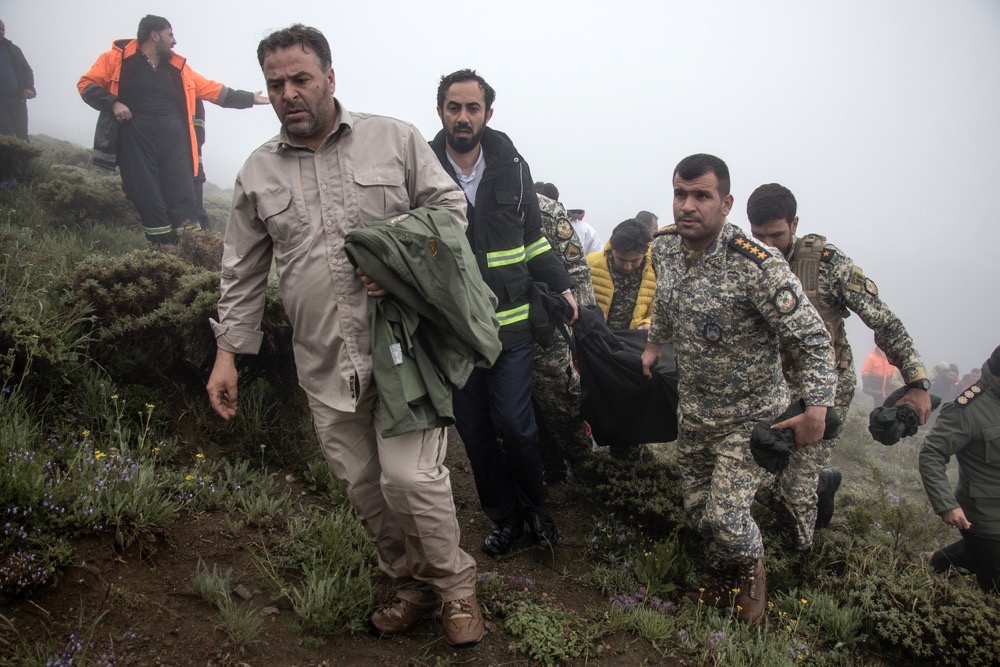
Raisi had earlier met Azerbaijan’s President Ilham Aliyev on their common border to inaugurate a dam project.
On the return trip, only two of the three helicopters in his convoy landed in the city of Tabriz, setting off a massive search-and-rescue effort, with several foreign governments soon offering help.
As the sun rose on Monday, rescue crews said they had located the destroyed Bell 212 helicopter — a civilian version of the ubiquitous Vietnam War-era UH-1N “Twin Huey” — with no survivors among the nine people on board.
State television channel IRIB reported that the helicopter had “hit a mountain and disintegrated” on impact.
Analysts have highlighted concerns about the safety of Iran’s civilian and military aircraft, many of which are in a poor state of repair after decades of US sanctions deprived the nation of new models and spare parts.
Iran has kept its civil and military aviation fleets flying during its isolation since the 1979 revolution through a combination of smuggled parts and reverse-engineering, according to Western analysts.
“Spare parts would have definitely been an issue for the Iranians,” Cedric Leighton, a retired US Air Force colonel, told CNN.
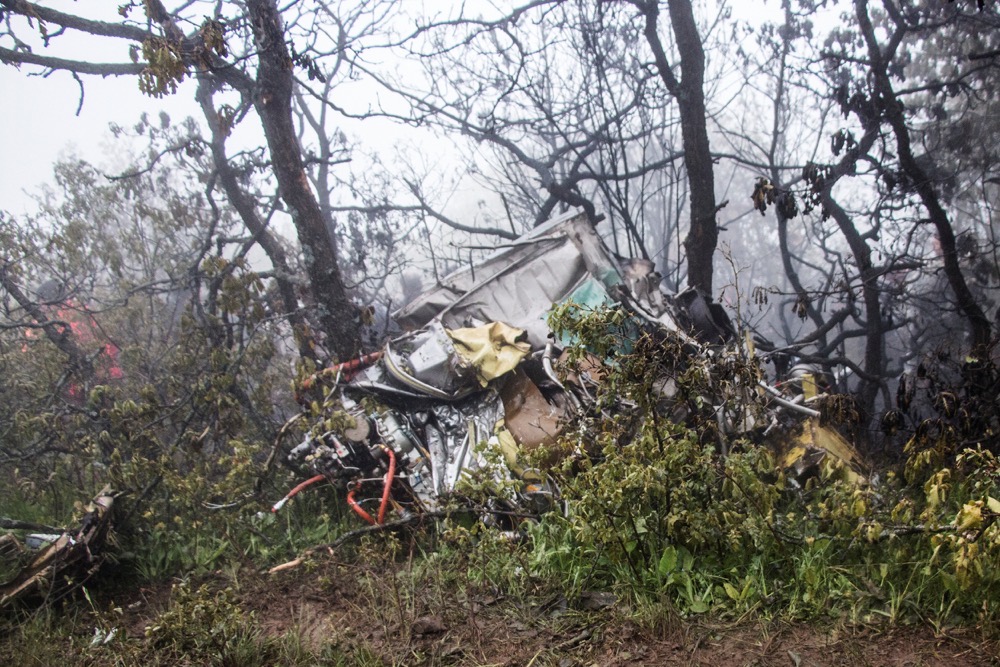
“In this particular case, I think this confluence of spare parts, because of the sanctions, plus the weather, which was very bad over the last few days in this particular part of northwestern Iran.
“All of that, I think contributed to a series of incidents and a series of decisions that the pilot and possibly even the president himself made when it came to flying this aircraft … And unfortunately for them, the result is this crash.”
Sunday’s incident is only the latest in a long history of air disasters that have claimed the lives of world leaders since the dawn of aviation.
One of the first instances of a serving leader or head of state to die in an air accident was Arvid Lindman, the prime minister of Sweden, whose Douglas DC-2 crashed into houses in Croydon, south London, while attempting to take off in thick fog on Dec. 9, 1936.
As the age of aviation took off during the interwar period, more and more leaders began taking to the skies for diplomatic visits and to touch base with the more distant corners of their dominions.
On Sept. 7, 1940, Paraguayan President Jose Felix Estigarribia died in a plane crash just a year after taking office, followed in 1943 by Poland’s prime minister in exile, Wladyslaw Sikorski, who died on July 4, 1943, when his B24C Liberator crashed into the Mediterranean shortly after taking off from Gibraltar.
While aviation technology and safety rapidly advanced after the Second World War as more and more countries began establishing their own air forces and civilian commercial fleets, technical faults, bad weather, and foul play continued to claim lives.
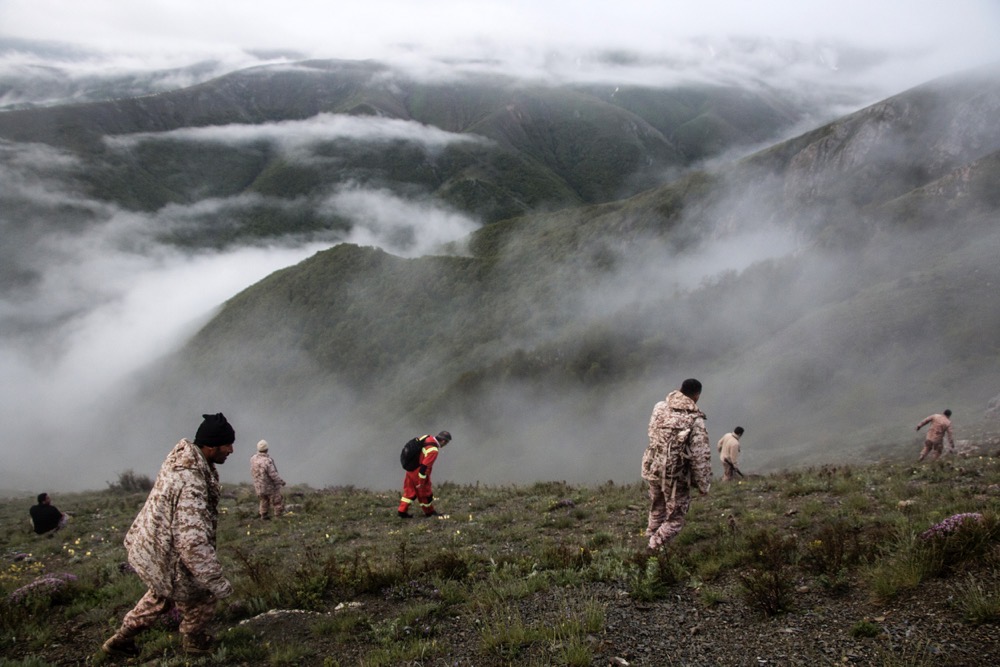
On March 17, 1957, Ramon Magsaysay, the president of the Philippines, was killed when his plane crashed into Mount Manunggal in Cebu. A year later, on June 16, Brazil’s interim president, Nereu Ramos, died in a Cruzeiro airline crash near Curitiba Afonso Pena International Airport.
Africa has also seen its share of air disasters. On March 29, 1959, Barthelemy Boganda, president of the Central African Republic, died when his Atlas flying boxcar exploded in midair over Bangui.
Then, in 1961, Swedish economist and diplomat Dag Hammarskjold, who served as the second secretary-general of the UN, died when his Douglas DC-6B crashed into a jungle in Zambia on Sept. 18.
With the 1960s came the widespread adoption of helicopter flight in conflict zones, search-and-rescue operations, and increasingly as an efficient way for politicians, diplomats and business leaders to get around and land in areas without an airstrip.
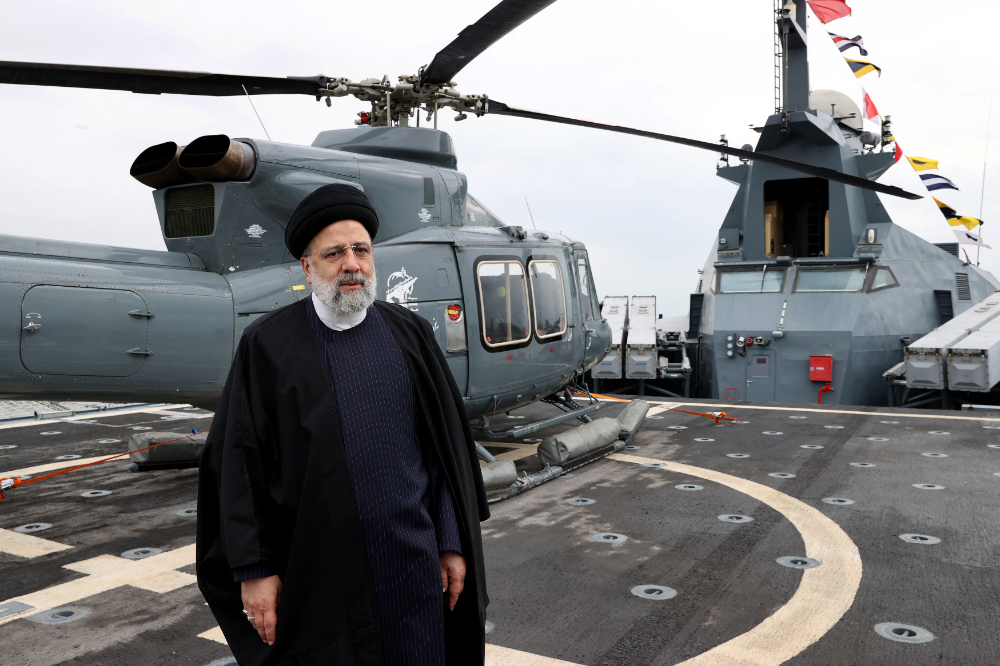
Like fixed-wing aircraft, however, helicopters are not immune to bad weather conditions, obstacles, human error, sabotage or terrorism.
One of the first world leaders to die in a helicopter crash was Abdul Salam Arif, the president of Iraq, who reportedly died when his aircraft was caught in a thunderstorm on April 13, 1966.
Similar incidents followed with the April 27, 1969, death of Bolivian President Rene Barrientos in a helicopter crash in Arque, and Joel Rakotomalala, the prime minister of Madagascar, in a crash on July 30, 1976.
Bad weather contributed to the death of Yugoslav premier Dzemal Bijedic on Jan. 18, 1977, when his Gates Learjet crashed into a mountain during a snowstorm.
Climatic conditions were also blamed when Ecuadorian President Jaime Roldos Aguilera’s Beech Super King Air 200 FAE-723 crashed on May 24, 1981, and when Mozambican President Samora Machel’s Tupolev-134A crashed while trying to land in a storm at Maputo on Oct. 19, 1986.
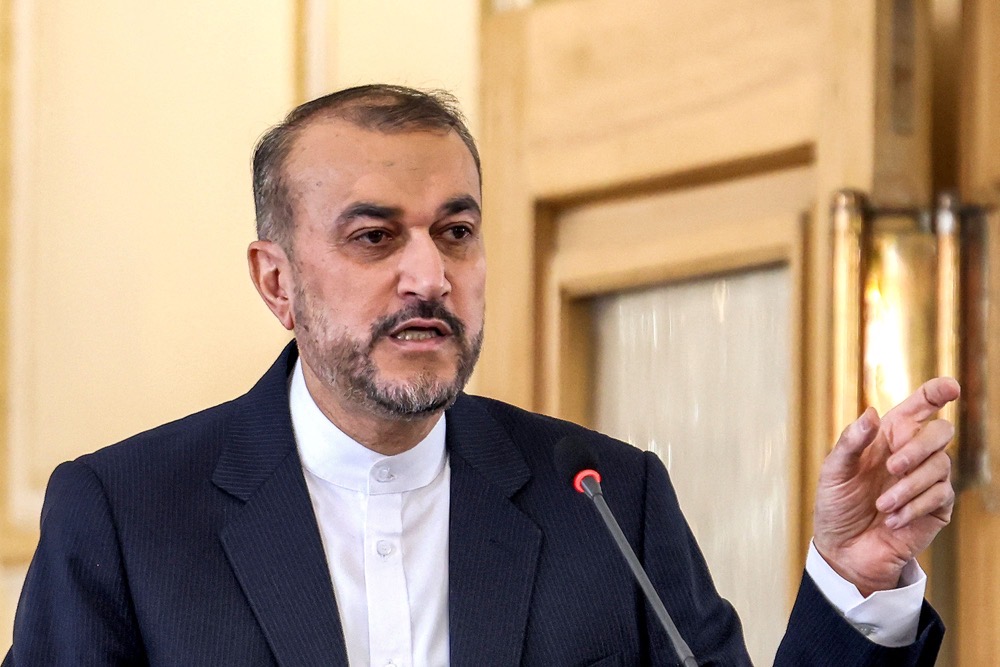
As the skies became busier, the potential for accidents grew. On July 18, 1967, Humberto de Alencar Castelo Branco, the first president of the Brazilian military dictatorship after the 1964 coup, died in a midair collision of Piper PA-23 aircraft near Fortaleza.
On May 27, 1979, Ahmed Ould Bouceif, the prime minister of Mauritania, died in a plane crash off the coast of Dakar, Senegal, and Francisco Sa Carneiro, who served as Portugal’s prime minister for only 11 months, died on Dec. 4, 1980.
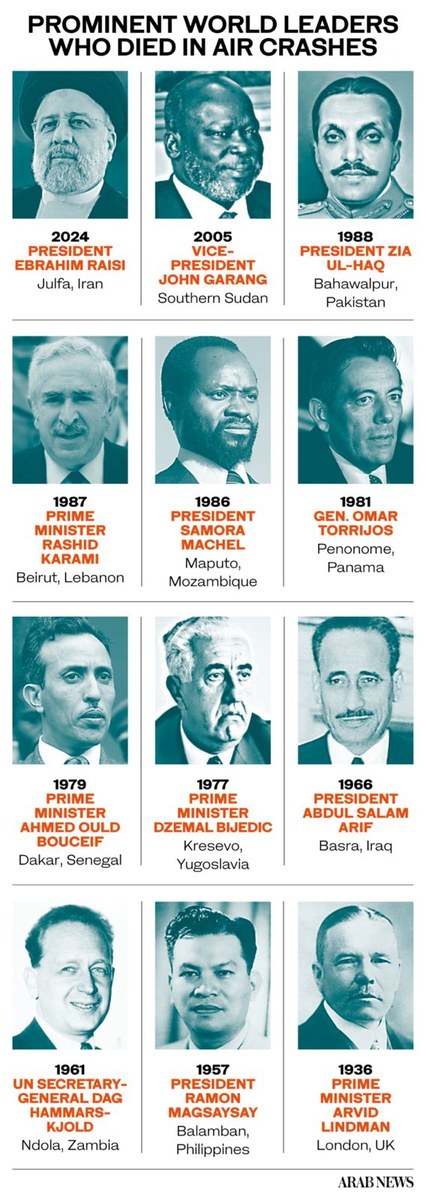
Not all crashes can be blamed on the weather or pilot error, however. In several cases, aircraft have been deliberately targeted as a means of killing their high-profile passengers.
Panamanian leader Gen. Omar Torrijos died on July 31, 1981, when his Panamanian Air Force plane crashed under suspicious circumstances.
On June 1, 1987, Lebanese statesman Rashid Karami, who served as prime minister eight times, was killed when a bomb detonated aboard his helicopter shortly after takeoff from Beirut.
In one particularly devastating incident, Rwandan President Juvenal Habyarimana and Burundian President Cyprien Ntaryamira were both killed on April 6, 1994, when their Dassault Falcon 50 9XR-NN was shot down while approaching Rwanda’s Kigali airport.
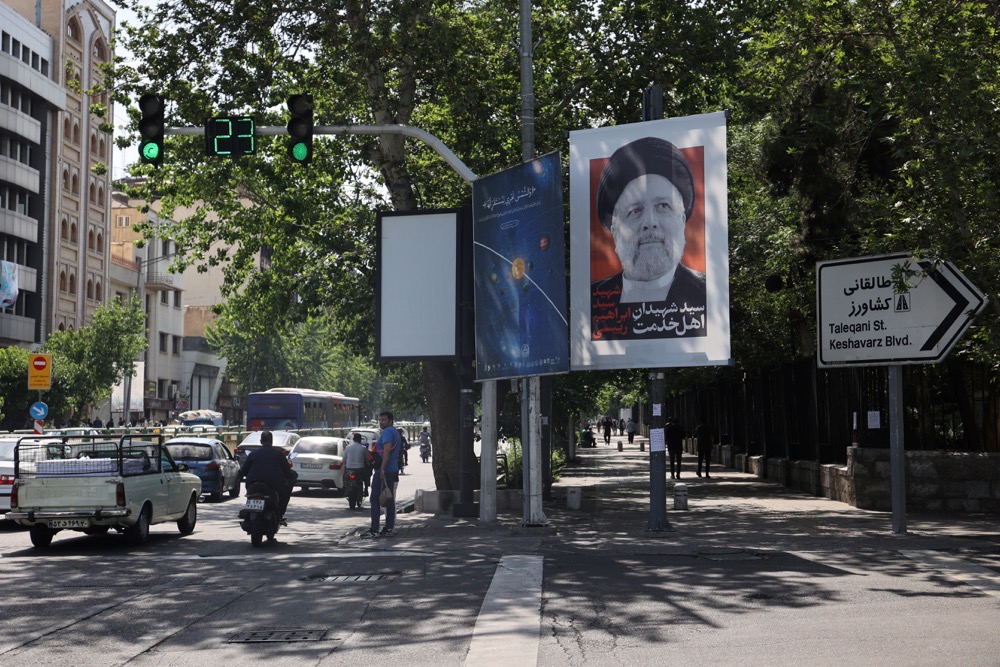
There have been several investigations into the air crash that killed Pakistan’s Gen. Zia Ul-Haq on Aug. 17, 1988, but no satisfactory cause was found, leading to a flurry of assassination theories.
The Pakistani Air Force Lockheed C-130B crashed shortly after takeoff from Bahawalpur. According to investigators, the plane plunged from the sky and struck the ground with such force that it was blown to pieces and wreckage scattered over a wide area.
Despite vast improvements in aviation safety, disasters have continued to strike well into the new millennium.
On Feb. 26, 2004, Macedonian President Boris Trajkovski died when his Beechcraft Super King Air 200 Z3-BAB crashed while trying to land in poor weather at Mostar.
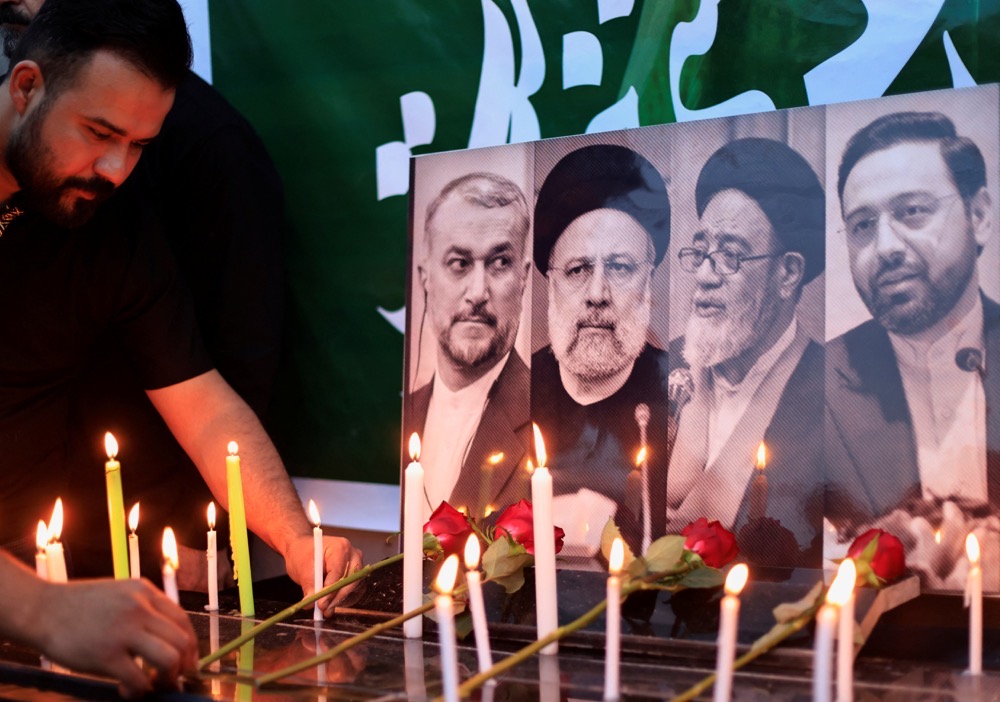
John Garang, leader of the Sudan People’s Liberation Army and briefly first vice president of Sudan, died when his helicopter crashed into a mountain range in the country’s south after getting caught in poor weather on July 30, 2005.
Muhammadu Maccido, the sultan of Sokoto in Nigeria, was killed alongside his son when his ADC Airlines Flight 53 crashed on Oct. 29, 2006, and Polish President Lech Kaczynski died on April 10, 2010, when his Tupolev-154 crashed in foggy weather when approaching Smolensk airport in western Russia.
In the latest incident prior to Raisi’s death, the deceased was actually at the controls when the aircraft got into difficulty. Chile’s former president, Sebastian Pinera, was killed on Feb. 6 this year when the Robinson R44 helicopter he was piloting crashed nose-first into Lake Ranco.

While this list of fatalities might give world leaders pause for thought as they step aboard their presidential jets on their next diplomatic outing, it is well worth remembering that modern air travel is statistically many times safer than traveling by road.
That said, an experienced pilot, an aircraft in good condition, a clear weather forecast, and a flight plan shrouded in secrecy would no doubt improve their odds of making a safe arrival.

More than 569 tonnes of aid delivered across floating pier into Gaza, says US CENTCOM

CAIRO: The US Central Command (CENTCOM) said on Tuesday more than 569 metric tonnes of humanitarian assistance has been delivered so far across a temporary floating pier to Gaza, but not all the aid has reached warehouses.
Aid deliveries began arriving at a US-built pier on Friday as Israel comes under growing global pressure to allow more supplies into the besieged coastal enclave.
The UN said that 10 truckloads of food aid — transported from the pier site by UN contractors — were received on Friday at a World Food Programme warehouse in Deir El Balah in Gaza.
But on Saturday, only five truckloads made it to the warehouse after 11 others were cleaned out by Palestinians during the journey through an area that a UN official, speaking on condition of anonymity, said has been hard to access with humanitarian aid.
The UN did not receive any aid from the pier on Sunday or Monday.
US says Iran sought help over president crash

- “Ultimately, largely for logistical reasons, we were unable to provide that assistance”
WASHINGTON: The United States said Monday that arch-enemy Iran sought assistance over a helicopter crash that killed president Ebrahim Raisi, as Washington meanwhile offered condolences despite saying he had “blood on his hands.”
The State Department said Iran, which has had no diplomatic relations with Washington since the aftermath of the 1979 Islamic revolution, reached out afer Raisi’s aging chopper crashed in foggy weather Sunday.
“We were asked by the Iranian government for assistance,” State Department spokesman Matthew Miller told reporters.
“We said that we would be willing to assist — something that we would do with respect to any government in this situation,” he said.
“Ultimately, largely for logistical reasons, we were unable to provide that assistance.”
He declined to go into detail or describe how the two countries communicated. But he indicated Iran was seeking help in the immediate aftermath to find the helicopter of Raisi, who died along with his foreign minister, Hossein Amir-Abdollahian, and seven others.
The crash came after the United States and Iran reportedly held their latest quiet talks in Oman aimed at increasing stability following open clashes between Iran and Israel.
The State Department in a statement offered “official condolences” over the deaths.
“As Iran selects a new president, we reaffirm our support for the Iranian people and their struggle for human rights and fundamental freedoms,” it said.
President Joe Biden’s administration described condolences as standard and not showing support for Raisi, who as a judge presided over mass executions of politicial prisoners and under whose presidency authorities have cracked down on mass protests led by women.
“This was a man who had a lot of blood on his hands,” National Security Council spokesman John Kirby told reporters, saying Raisi was responsible for “atrocious” abuses.
Kirby said, however, that “as in any other case, we certainly regret in general the loss of life and offered official condolences as appropriate.”
The United States has often but not always offered condolences in the past to leaders it opposed with such messages sent over Joseph Stalin, Kim Il Sung and Fidel Castro.
But the condolence message, along with similar words from European nations, brought anger to some opponents of the clerical state who saw Raisi’s death as reason to celebrate.
Masih Alinejad, a women’s rights activist who US investigators say was the target of an assassination plot in New York engineered by Tehran, wrote on X, formerly known as Twitter, “Your condolences only pour salt on the wounds of the oppressed.”
Defense Secretary Lloyd Austin indicated that US forces have not changed their posture after the crash in Iran, where decisions are ultimately made by the supreme leader, Ayatollah Ali Khamenei.
“I don’t necessarily see any broader regional security impact,” Austin told reporters.
He preemptively denied any US role and said there was no reason to think it was anything other than an accident.
“The United States had no part to play in that crash. That’s a fact, plain and simple,” Austin said.
“It could be a number of things — mechanical failure, pilot error, you name it,” he said.
Iran’s military ordered an investigation. It has often in the past blamed security incidents on Israel and the United States, which both in recent years have struck Iranian targets.
Former foreign minister Mohammad Javad Zarif blamed the crash on continued US sanctions which have impeded the sale of aviation parts.
Asked about Zarif’s remark, Miller said: “Ultimately, it’s the Iranian government that is responsible for the decision to fly a 45-year-old helicopter in what was described as poor weather conditions, not any other actor.”


















